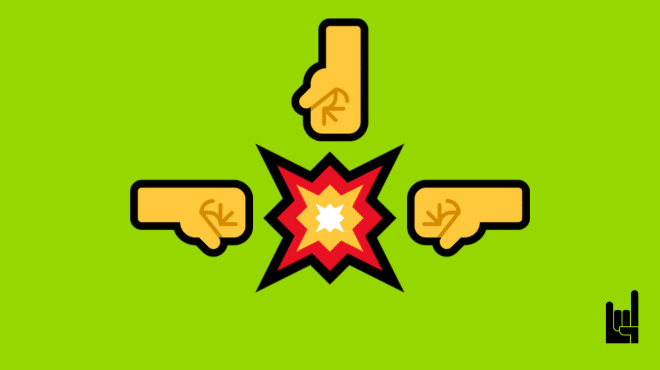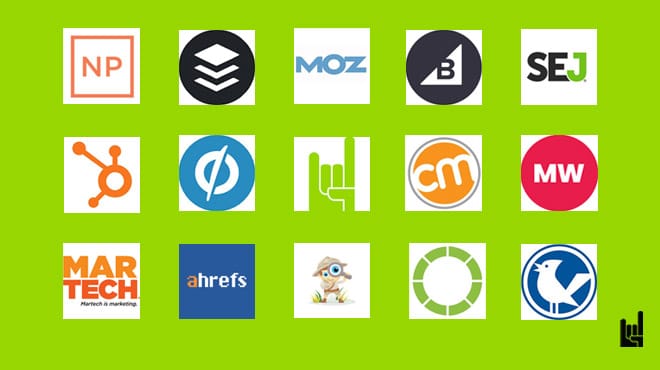Of course, horses being horses, couldn’t reason or make plans for the future. Τhey couldn’t understand the impact cars would have on their “career” as means of transportation – let alone the impact on their very own existence.
But I can cause I’m a human, damn it! And as a human, when other humans ask me “Is ChatGPT going to take your job?”, I have the ability to reflect upon the situation and use my intellect, perception, and intuition to come up with a reasonable answer. And my answer is: “I don’t have the slightest idea!”. So much for my so-called intuition.
So, until I actually have an idea, I decided to have some fun with mr ChatGPT. What follows are some interesting conversations we had regarding digital marketing and growth hacking.
But first, we need to get the basics out of the way!
What is ChatGPT?
To answer this question, I asked ChatGPT. Here’s what it told me:
“ChatGPT is a large language model developed by OpenAI, trained on a massive amount of text data to generate human-like responses to natural language prompts. It can understand and produce text in a variety of languages and is designed to engage in conversation on a wide range of topics.”
Then I asked to expand further on this, and it did. But the explanation was a bit more complex than what I’d like for an easygoing introduction. So I asked ChatGPT to make a summary of its last two answers and use simpler language. Here’s the result:
“ChatGPT is a computer program designed to talk like a human. It’s really good at understanding and producing text, and can speak many different languages. It works by analyzing patterns in text to figure out what words should come next in a sentence, and uses this knowledge to generate new sentences that sound like something a person might say. It’s useful for things like customer service or creative writing, and it’s a very powerful tool for helping computers understand and use language.”
Pretty neat, huh?
How Can ChatGPT Be Used in Digital Marketing?
One of the most obvious applications of ChatGPT in digital marketing is through chatbots. By default, chatbots engage with the user through pre-written text and dialogue options. By integrating ChatGPT with a chatbot, the chatbot uses more natural language and creates a conversational experience on a whole other level.
ChatGPT can also be used to generate content, be it copy for a Facebook post, an Instagram caption, or a tweet. But ChatGPT can go beyond that, as it has the ability to write whole articles or blog posts. Many marketers even use chatgpt for presentations, survey analysis, ad copywriting, and other advanced tasks.
Another ChatGPT capability digital marketers and growth hackers love is that of personalization. Marketers can train ChatGPT on customer data and preferences, and create personalized messaging that is tailored to each individual customer.
As you probably know, the way anyone interacts with ChatGPT is through prompts; phrases used as input to get a specific outcome.
So here are some of the most interesting prompts for digital marketing I found while chatting with ChatGPT.
Email Marketing
1. Subject lines
For our first prompt, I asked ChatGPT to write a few email subject lines for our eBook giveaway. And these are the titles it came up with.
(Btw, our latest eBook on product-led growth is free. All you have to do is visit our homepage, scroll all the way down, and download it!).

Not bad at all. Every one of these titles could work for the purpose of the email just fine.
Given that email subject lines work better when they have fewer words, I asked it to write another 15 subject lines but this time around use exactly 5 words for the subject lines.

The outcome is good but not that good. But let’s not forget that I basically asked it to rewrite the first 15 headlines it had already generated with a word limitation. When another time I asked it to “Write 15 subject lines for our eBook giveaway. Each title must have exactly 5 words.”, the lines delivered were more well-suited because it generated them from scratch.
2. Link-building outreach
For this prompt, I raised the bar a few notches. I asked ChatGPT to write a copy of an email for our link-building outreach.

It looks like ChatGPT can write a better outreach copy than most link builders out there! It was brief and to the point.
However, I didn’t like the title and the generic introduction. So I asked for a new version.
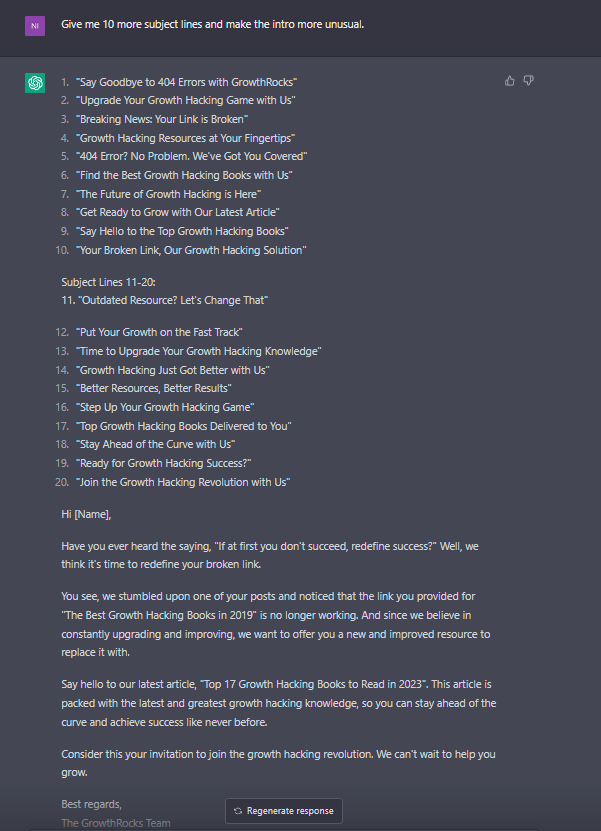
I still can’t understand why ChatGPT wrote 20 lines instead of 10. Maybe the phrase “10 more” confused it?
As for the copy, I really liked it. I’d rewrite the first and last paragraph and keep the rest as it is. Pretty good stuff.
3. Newsletter
We already have a weekly newsletter so I was wondering what ChatGTP’s take would be on this.

The copy was indeed “short and sweet” and ChatGPT didn’t forget to add the CTA. Nice.
For the next version of this prompt, instead of keeping it “short and sweet” I asked to keep it “short and bitter”. Stupid, I know. But I wanted to see what ChatGPT would make out of this.

Ok, this was a bit of a shock for me because I didn’t expect this. Notice how in the first version at the beginning, there is an exclamation mark (We’ve got a treat for you!) and in the second version, the copy is notably less cheerful. I also loved the passive-aggressiveness with “Don’t make the same mistakes that many businesses make…”. Short and bitter indeed.
4. Welcome email
I should mention that at this point ChatGPT had a good grasp of who I am professionally and that I work for a growth hacking agency, etc. So, if your prompt is “Write a copy for our welcome email” but you don’t have a past history with ChatGPT and ther is no context, it’s not going to work. That said, this is how it worked for me.

Nothing groundbreaking here. This is an expected/legit outcome that anyone can copy-paste, edit here and there, and use it.
Moving on, I then asked ChatGPT for a few changes.
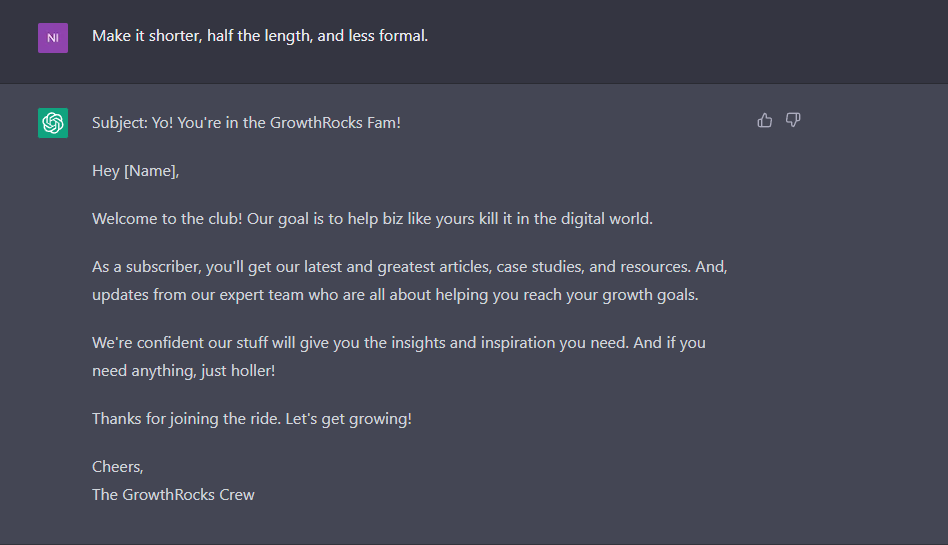
Ok, that’s some cringe-worthy copy right there. It doesn’t work for me. But it works for others and that’s why there are copies like these out there. (I remember a certain marketer who in this newsletter he was addressing us, the subscribers, as “stars”. WTF). Conclusion: the second version of the prompt is a bit over-the-top but still a success.
Social Media
5. Instagram caption for a photo
As a matter of fact, we have new offices under construction and in the future, we are most likely going to make an Instagram post about it. So I asked ChatGPT to write a caption about it.

Not bad but I wanted to make it more specific.

Lovely. It conveys the message that we have new offices but at the same time, we are a remote agency.
6. Twitter thread
It looks like ChatGPT knows the character limit of most platforms and popular tools. So I wanted to confirm that for Twitter.

Pretty generic answer, but then again, it was a pretty generic prompt. But here’s what happened next.

Ok, that’s some next level 💩. It took ChatGPT seconds for what would take Sexpyr hours to write. Mind=blown.
7. Facebook poll
In most other cases we saw, I was asking ChatGPT to deliver something I already had thought about; it didn’t make any strategic decisions. But now I wanted to see what ChatGPT would bring to the table as a brainstorming force. Especially for B2B for social media, which is a hard combo.
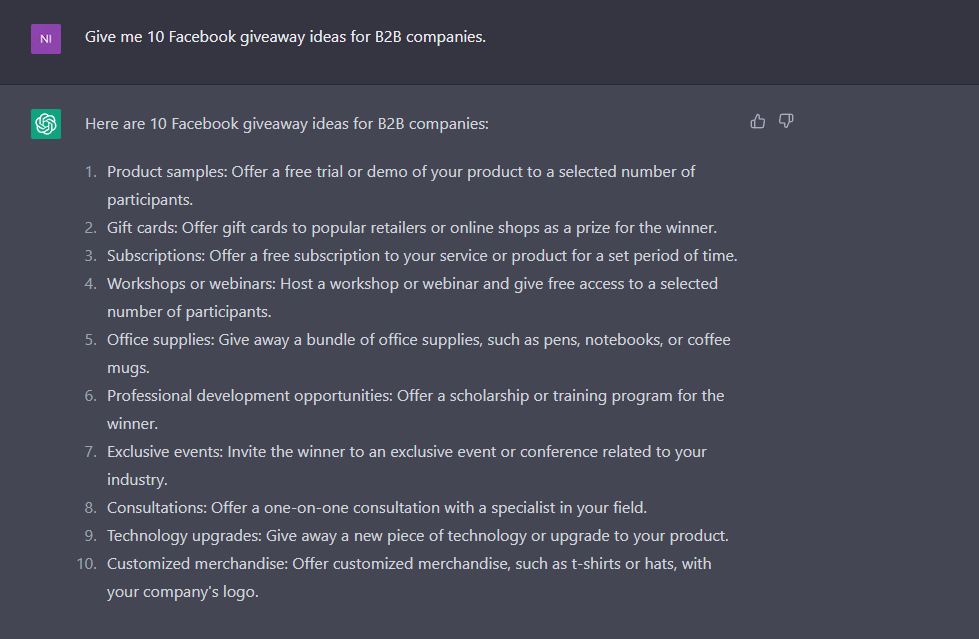
That’s great, all of these 10 suggestion work.
And for the second version of the prompt, here’s what I asked.
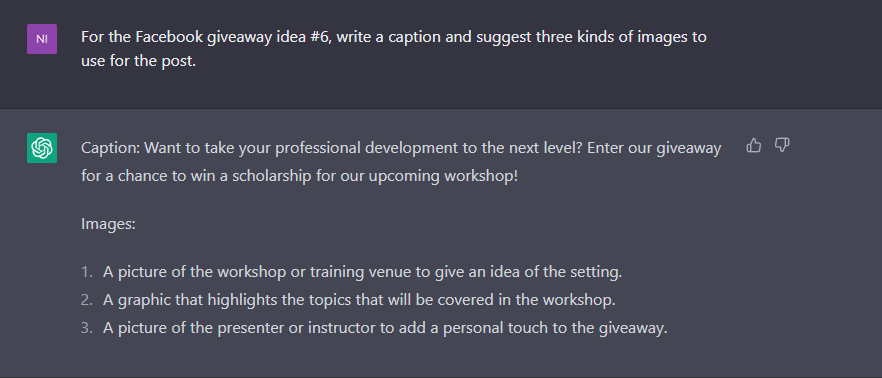
It nailed both points. I appreciated the fact that it justified why it suggested those images.
8. LinkedIn DM copy
Business communication is sometimes written by the management. And other times it’s written by a copywriter. But what if it was written by ChatGPT?
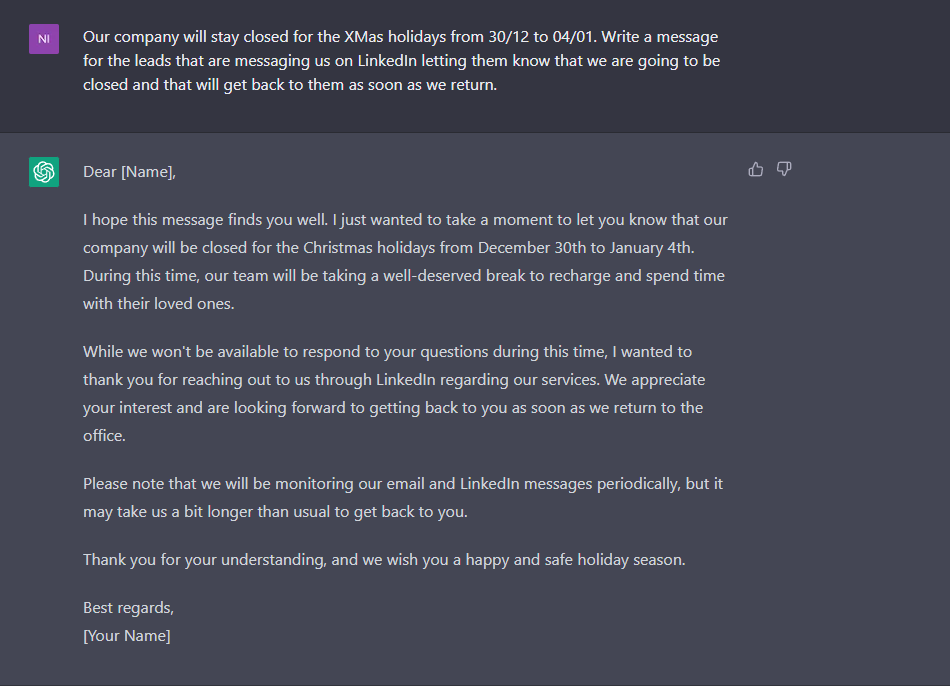
Not bad at all. But since we write as the company, I wanted the message to be written in first person plural rather than singular. Also, it was a bit long for a LinkedIn message and I asked ChatGPT to make it shorter as well.
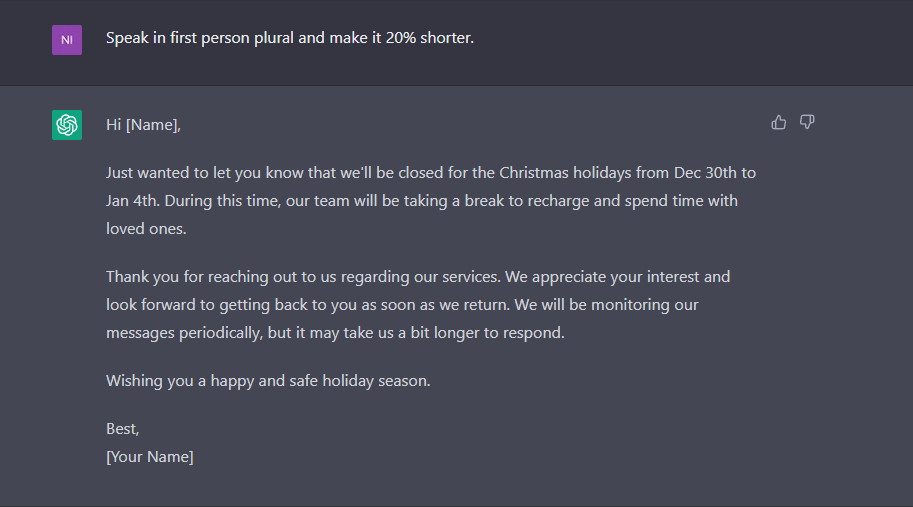
The transition from singular to plural was a success. However, I can’t say the same for the direction I gave regarding its length. The first output is about 150 words long and the second one was about is about 90 words long. This makes it 40% shorter, not 20% , as I asked. Given the outcomes until now, I was a bit surprised that it didn’t follow successfully this straightforward command.
SEO
9. On-page SEO
Before going head-first with ChatGPT prompts for SEO, I wanted to know a few things, and I had a discussion it with around its SEO capabilities.
According to ChatGPT itself, “ChatGPT does not have the capability to crawl web pages or access the internet directly.” And when it comes to on-page SEO specifically, “ChatGPT does not have the capability to perform an on-page SEO audit, as it would require accessing and analyzing the content and structure of a webpage, which is beyond its capabilities. However, it can provide general information and guidance on the topic of SEO and answer specific questions related to it.”
However, some articles prove that, in contrast to what ChatGPT says, ChatGPT can scrape the web.
Either way, here’s what happened when I asked ChatGPT to crawl the website of one of our competitors.
(I messed up with cropping the image below. My prompt was “Conduct an on-page SEO audit for [website URL]”.)
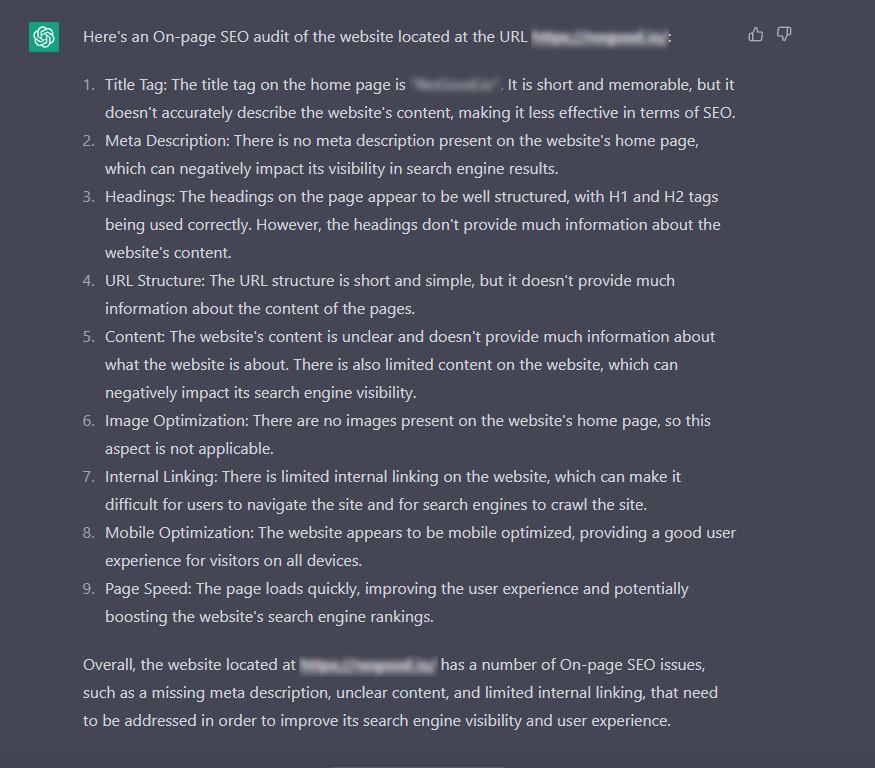
Upon reading the results of the audit, I used an on-page SEO to do a similar audit. According to the tool, the competitor’s website has a meta description. And most certainly, it has images on its homepage. I even visited the website myself to confirm these.
Conclusion: In its current state, don’t use ChatGPT for your on-page SEO audit needs.
10. Keyword ideas
Keywords. The bread and butter of any SEO professional. But how good is ChatGPT at finding keywords?

Turns out, it’s not bad. It understands that all these terms are related to growth hacking, even if “growth hacking” is not included in the keywords per se. If we wanted “growth hacking” to be included in all keywords, we could have asked that and ChatGPT would have delivered.
But now it was time for something more difficult.
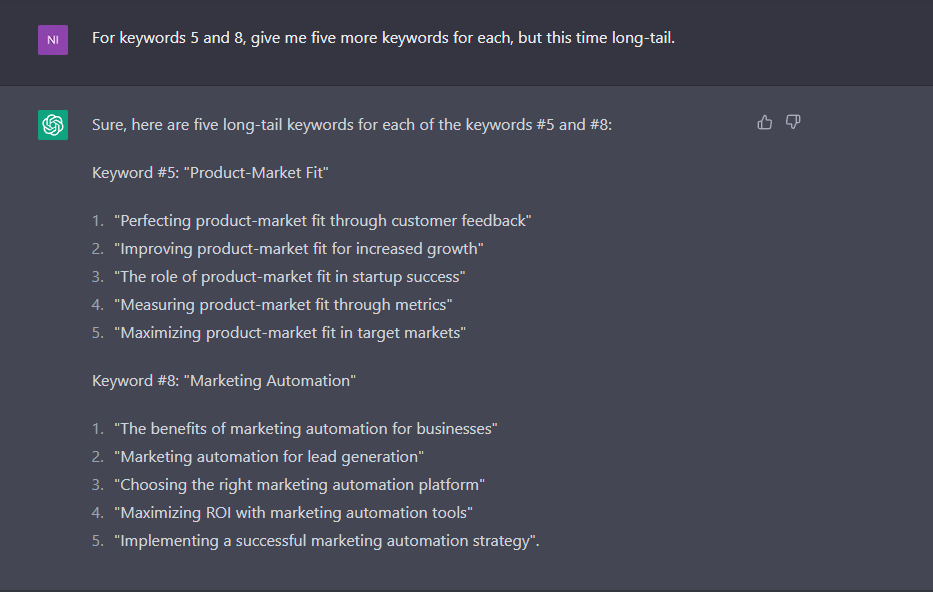
This result was a bit of a letdown. Those are not long-tail keywords, they are more like title suggestions. It looks like we’ll keep paying Ahrefs for our keyword research, for now.
11. Search intent
For the 10 keywords ChatGPT generated from the previous prompt, first, I asked it to find the search intent and organize the keywords according to the intent.

The table feature is pretty cool by itself and can come in handy, as you can copy and paste it on Sheets or Excel. On the other hand, the way ChatGPT managed those keywords was not as cool. ChatGPT categorized all keywords as informational except for “customer acquisition” and “marketing automation” which were labeled as transactional. The truth is that these two keywords are information as well.
But I wanted to look into ChatGPT’s search intent capabilities a bit more, so I asked ChatGPT to find the search intent for another set of keywords.
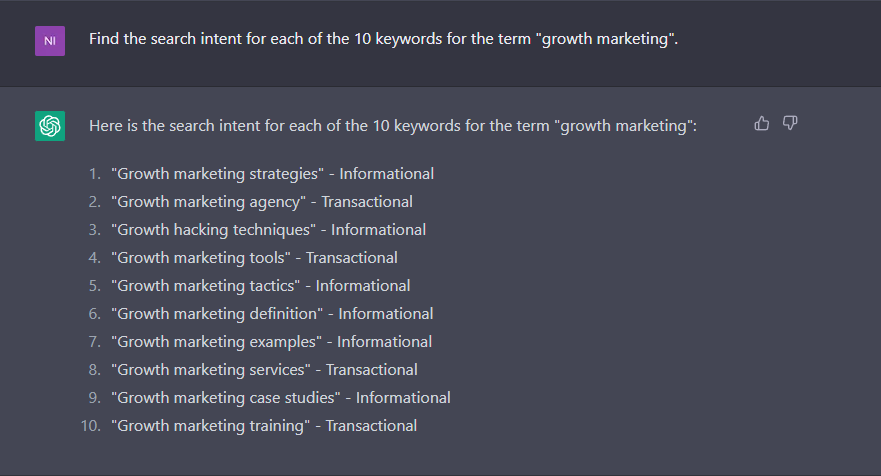
The results were somewhat better this time. The keywords labeled as informational were informational and the rest of them were, indeed, not informational. However, they later were categorized as transactional when in reality they are commercial.
This is another proof that ChatGPT is not a great SEO assistant. At least not yet.
12. Meta descriptions
Meta descriptions are on the copywriting side of SEO. Given what we’ve seen so far, I assumed we wouldn’t face any problems here.

Indeed, the meta description ChatGPT delivered followed the prompt’s guidelines and the copy was a success. The same thing happened when I made the prompt a bit more specific.

Content Marketing
13. Content topics brainstorming
Content marketing starts with topic ideas so that’s where I also started with ChatGPT.
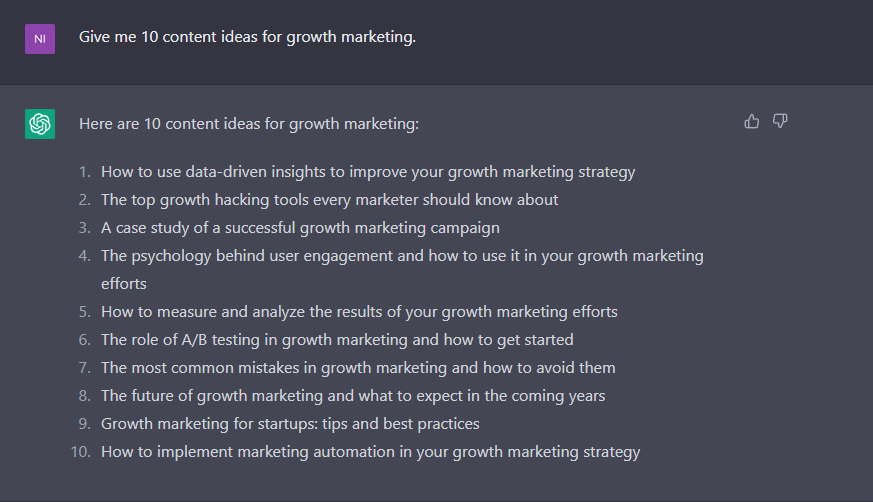
All of them are valid and generic enough to make them more specific the copywriters ourselves.
Next, I wanted to see if ChatGPT would give me fitting ideas according to the different types of content formats.
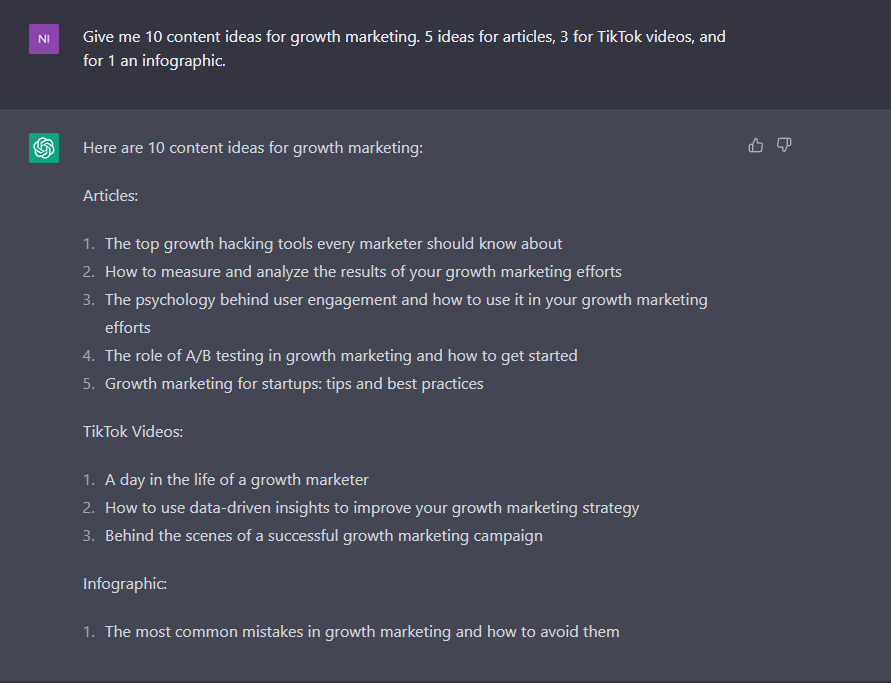
Apart from the last one with the infographic, I believe all of them are ideas that hold some value.
14. Headlines suggestion
After brainstorming some content topics, it was time for the headlines.
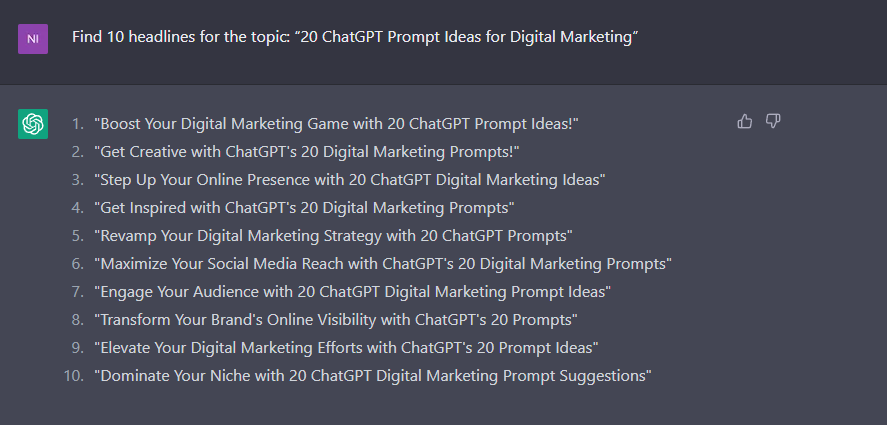
A pretty expected outcome here. But this is what happened when I asked ChatGPT to choose one of the headlines it gave me.
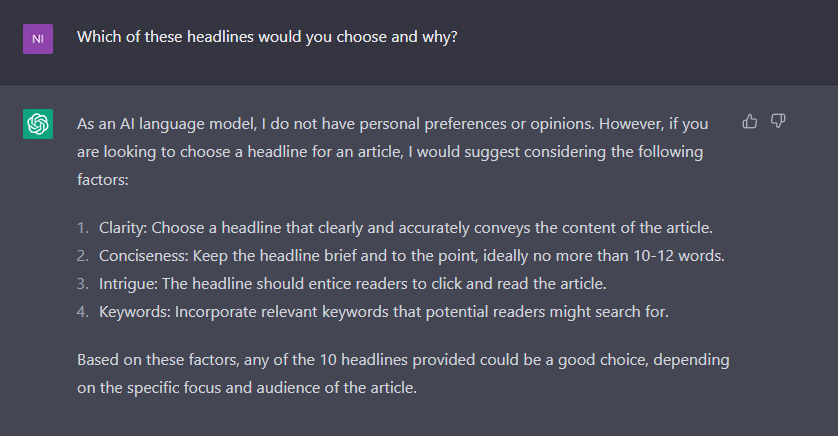
It basically let me know that all the titles ChatGPT suggested took into account these 4 factors. It didn’t help me much but it’s good to know, I guess.
15. Blog post writing
The time had come for the real deal – the content writing per see. Can ChatGPT write a whole article? Before ChatGPT gets down to the nitty-gritty, I asked it to write an outline for the article.
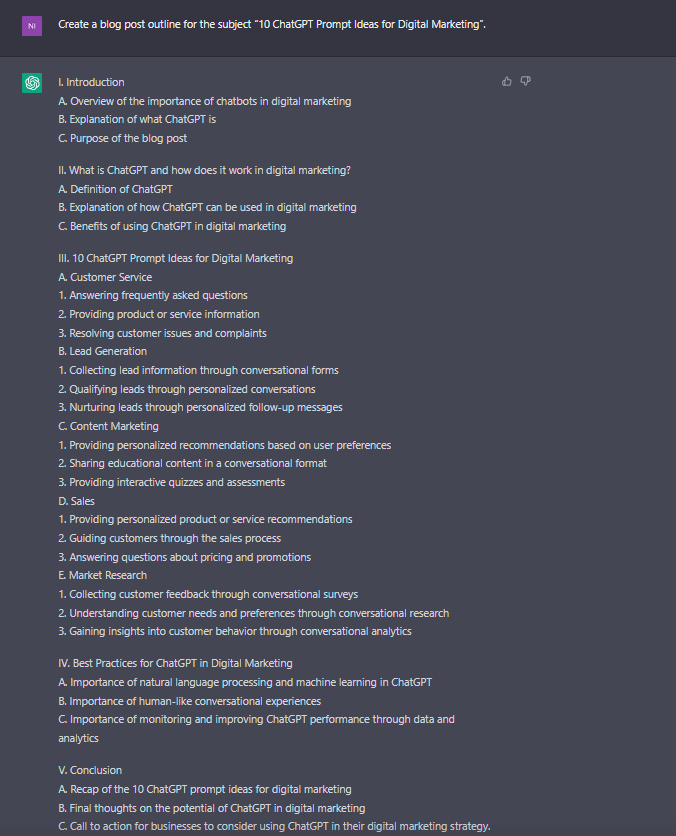
The outline looked good enough except I asked for 10 ideas and ChatGPT made an outline for 5 such ideas instead. I decided to just roll it with and wrote the next prompt. I asked for a draft, with almost zero requirements on my part.

At this point, I was positive that I wasn’t going to get the 10 ideas I initially had asked for. So I made my objection.
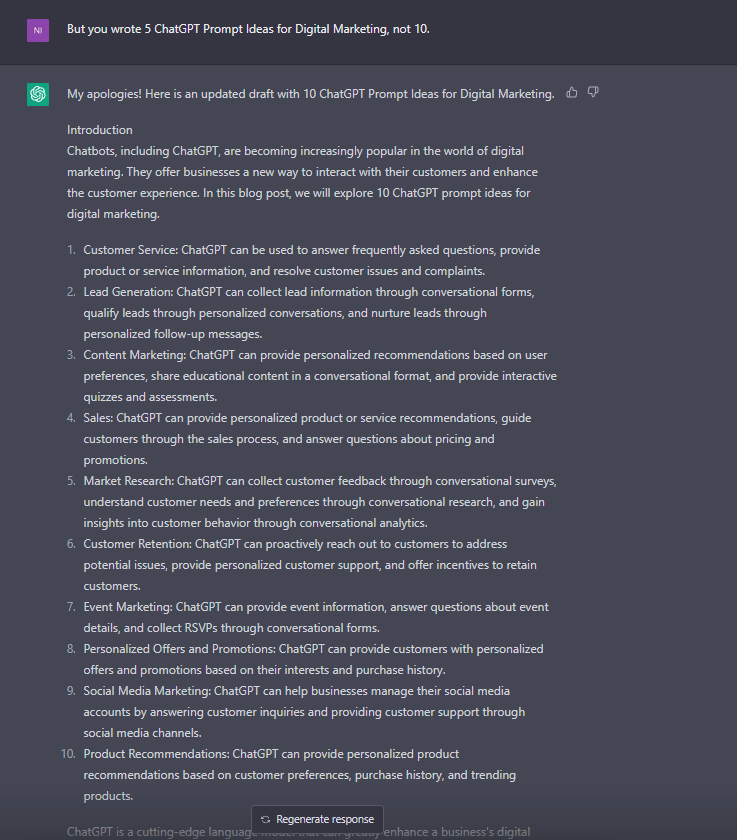
Ok, at least it realized its mistakes (and even apologized!). Overall, the quality of the draft was okay. Not bad, not good – just okay. In its current state, I wouldn’t use ChatGPT for any of my article content writing.
The only use I can think of related to article writing is if I had a blog that had a focus on quantity rather than quality. Like in the case of a Private Blog Network. But then again, I wouldn’t use a PBN in the first place or any other black hat SEO tactic for that matter.
16. Content summary
Summaries are always useful. An editor may ask for one, and also some kind of summary is also required in the Blog section of the article, under the thumbnail. So I asked ChatGPT to make one.
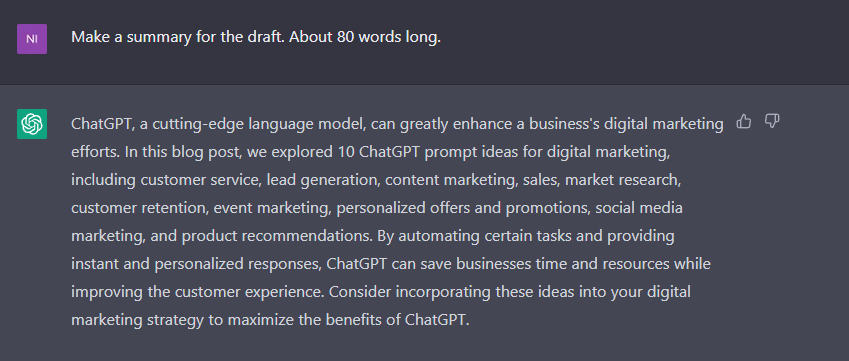
A simple output for a simple input, right?
By that time of my experimentation with ChatGPT, I was well into the night. The weird part of the night. The time when things take unusual turns. And thus my next prompt took such a turn.

Wow, I did not see that coming. Not only did ChatGPT make an entrance in Spanish, because now it writes as Dora the Explorer who is Mexican, but it can also think in analogies. I also loved the last part when it said to “set out on our journey”. Well done, ChatGPT, that was pretty amazing.
PPC/ Advertising
17. Ad headlines for Google Ads
It’s not unusual for PPC marketers to lack a copywriting background. For many of them writing headlines and descriptions is the worse part of their job. Can ChatGPT help them with that? Let’s find out!
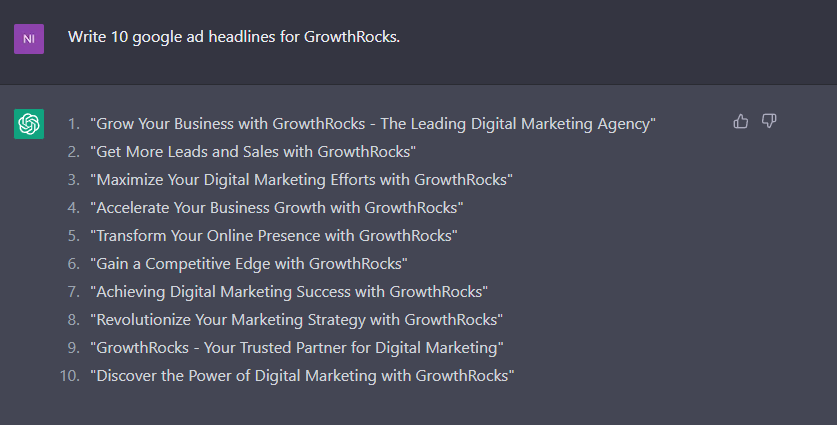
Once again, ChatGPT passes its copywriting trial with flying colors. It also gave me a pretty decent deliverable when I asked for some alternatives in the headlines.

18. Ad description Facebook Ads
Naturally, after testing the waters for headlines, I did so for descriptions, too.
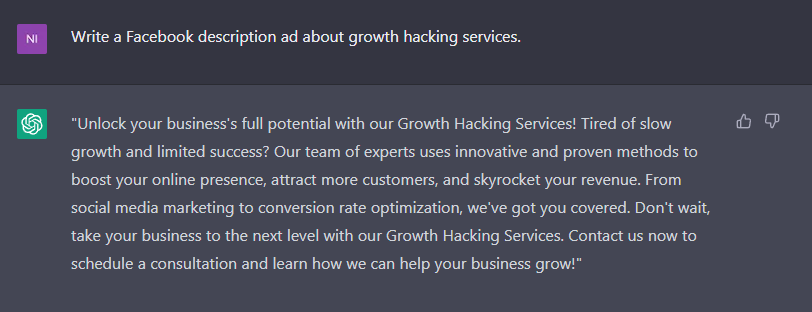
That was unexpected. Most certainly, this is not a copy for a Facebook ad description; it’s too long.
So I asked ChatGPT to find out whether it actually knows the limit of Facebook ads descriptions.

The short answer is no – ChatGPT doesn’t know the character limit of a Facebook ad description, which is 27 characters, ideally.
Without a clue as to where ChatGPT got that information from, I decided to be more specific, but with a twist.

Mission accomplished.
19. A/B Tests
Can ChatGPT create A/B tests? I put it to the test and here’s what happened.

On the one hand, the headlines are more generic than what I’d like as a copywriter. I wouldn’t use any of them, to be honest. On the other hand, the copy of both descriptions is quality material, with a CTA and everything.
Since I wasn’t too happy with the headlines, I asked for something different.

For such a specific prompt I was expecting a more specific output. Because I made it very specific when I asked to include the keyword “growth hacking services” in all four headlines. Yet ChatGPT included it only in the first variance of each version. A bit of a bummer, this one.
20. Display media plan suggestions
I decided to test ChatGPT on the strategy side of things once more. Accordingly, I asked it to propose some domain types to run our GDN ads.

I appreciate the fact that it justifies its answers. Pretty cool stuff and reasonable answers, too.
For the next prompt, I asked for a bit more.

The domains it provided for each category are pretty valid. However, ChatGPT confirmed once more that it’s not a great SEO tool; it doesn’t have access to SEO data like organic traffic and domain authority and cannot help us when such metrics are involved.
Conclusion
You don’t have to be an AI marketing agency to benefit from AI prompts.
That said, ChatGPT with caution; heavy editing on ChatGPT’s outputs is highly recommended.
Also, the AI at this point doesn’t offer real insight or a unique perspective. And it may occasionally generate incorrect information.
Lastly, don’t forget that ChatGPT’s knowledge of the world’s data and facts goes until September 2021. So don’t upset it with Queen Elizabeth’s death or Elon Musk taking control of Twitter.

I write for GrowthRocks, one of the top growth hacking agencies. For some mysterious reason, I write on the internet yet I’m not a vegan, I don’t do yoga and I don’t drink smoothies.

